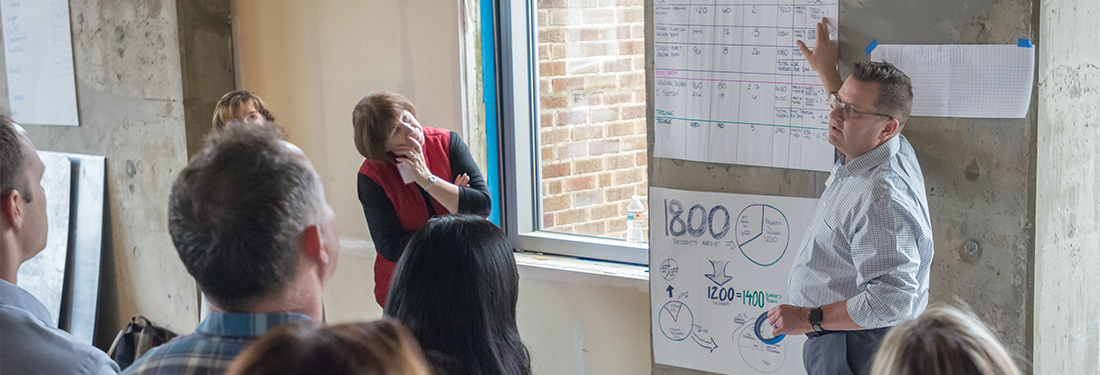Eliminating Waste and Providing Value to Patients Who Receive Total Joint Replacements
Virginia Mason has worked with the Dr. Robert Bree Collaborative to provide greater value for patients through the use of evidence-based care bundles, which map out efficient ways to deliver health care services by reducing variation and improving safety. Like us, the Bree defines value from the perspective of the customer — whether those customers are patients, payers or purchasers. Further, when assessing a service’s value, Virginia Mason and the Bree take the entire patient experience continuum into consideration, from symptom recognition all the way through a patient’s return to function.
This shared vision of value has enabled our Virginia Mason teams to execute value-based purchasing criteria, as defined by the Bree, in our improvement work. We do this by putting the patient first in everything we do and by abiding by a single management method that allows us to enact change across institutional and departmental boundaries.
A clinical research trial showed us the value for patients
During a clinical research trial that proved to be a win for patient experience, my team of leaders, providers and staff concluded that compared with the placebo group, the use of continuous adductor canal blocks for patients’ total knee arthroplasty not only reduced opioid consumption, but also resulted in stronger quadriceps, better pain scores and the ability to walk longer distances. This work set the stage for the Bree’s patient-centered bundle for total joint replacements that was to come.
Inspired multidisciplinary work removed waste, increased value
Building upon this research, we implemented several changes to our perioperative clinical pathway. We knew that the benefits of adductor canal block improved quality, but we also knew that we needed to eliminate waste in the perioperative clinical pathway to make this successful for all patients.
Because our pathway across the patient care continuum required seamless, visible communication across departments, we developed simple and clear visual controls — information about the patient that travels with the patient — so that everyone could see where patients were in their journey. The controls also allowed us to see immediately when a patient went off the pathway or when an element of the bundle was missing, so that we could act to correct it.
To eliminate unnecessary variation in the process, we used the bundle as standard work. By making it visible, we could see when unique patient characteristics led staff to provide unique care beyond the bundle. Making it visible also meant that there weren’t defects creating confusion or rework along the way.
Through this work, we were able to provide every patient with the highest possible quality. By using our lean management method, Virginia Mason’s leaders, providers and staff worked together to eliminate the waste in our processes so that all our patients undergoing total knee arthroplasty could experience the same outcomes. In all, the work required the engagement of more than 400 staff across the patient’s continuum of care.
The results made a clear difference for our patients, decreasing a patient’s length of stay from 76.6 hours to 56.1 hours, without a jump in readmissions.
“Through this work, we were able to provide every patient with the highest possible quality. By using our lean management method, Virginia Mason’s leaders, providers and staff worked together to eliminate the waste in our processes so that all our patients undergoing total knee arthroplasty could experience the same outcomes.”
Tackling readmissions further increased value for patients
However, because Virginia Mason views any readmission as a defect in care, we were inspired to do more work to achieve zero defects. Our team members agreed that it was just as important to deliver value after a patient leaves the hospital. Therefore, in an improvement event designed to reduce readmissions, my team developed, tested and implemented a process of real-time signaling and root-cause analysis of a readmission after total joint replacement.
Now, even though our readmission rate after total joint replacements is very low, when a readmission does occur the clinical team responds immediately. Together the team members study why the event occurred and enact countermeasures to prevent the occurrence for future patients. This real-time root-cause analysis has been so successful that we spread it to our spine-surgery bundle.
The value extended to employers
Today, thanks to the work developed at the Bree and Virginia Mason, the Washington State Health Care Authority contracts with Virginia Mason to provide hip and knee joint replacements for its employees. Using bundled payments, the state pays Virginia Mason one sum for the care of each patient from diagnosis to the patient’s return to function. And since Virginia Mason’s leaders and engaged frontline staff have worked together to develop, test and implement innovative processes showing remarkable outcomes, not only are patients experiencing greater value, but employers are benefiting too.





